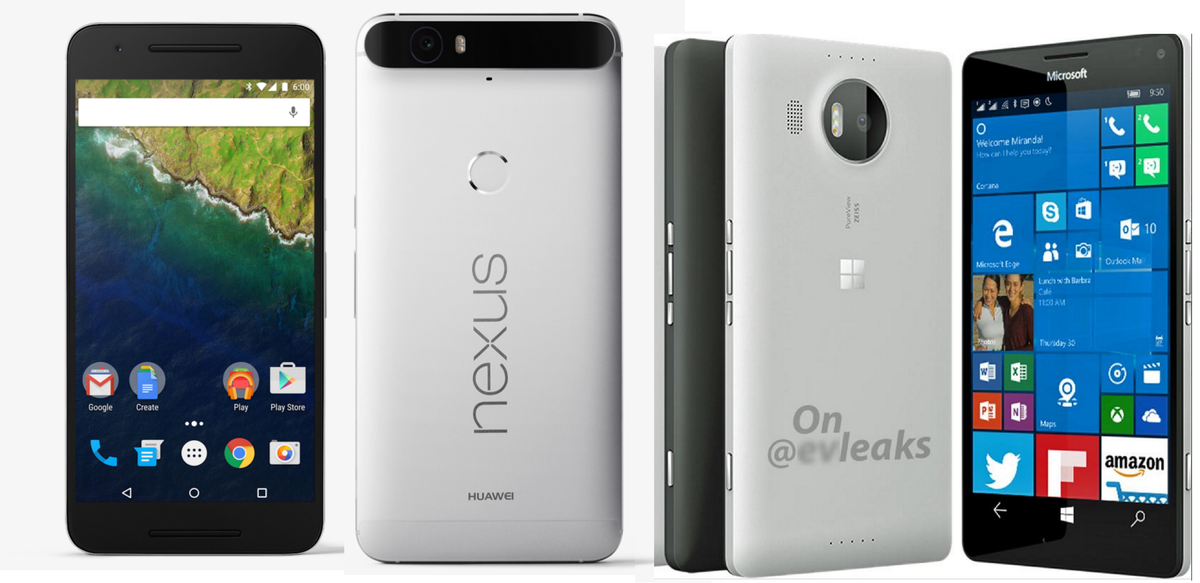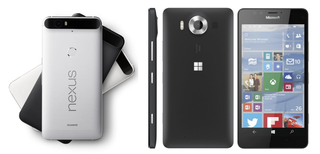How the Nexus 5X and Nexus 6P stack up against Lumia 950 and Lumia 950 XL Windows Phones

Earlier today, Google announced their new Nexus phones dubbed the Nexus 5X and Nexus 6P made by LG and Huawei respectively. Both phones are available for pre-order now and will ship in 3 to 5 weeks, depending make, model and configuration chosen.
Google is apparently taking a page out of Apple and Samsung's book by offering direct support and even an insurance program to protect their phones. With Microsoft set to announce their new phones – the Lumia 950 and Lumia 950 XL – in just a week's time, comparisons are inevitable.
Let's see how the Nexus 5X and 6P stack up against the not-yet-announced new Lumias.
Before we jump in, we should note that since Microsoft has not yet announced their new Lumias many details are just not known, including specifics about the camera, general availability, pricing, and more. In that sense, this comparison is certainly premature. However, we now know enough about both Lumias to get a general idea.
| Category | Nexus 5X | Nexus 6P | Lumia 950 | Lumia 950 XL |
|---|---|---|---|---|
| Operating System | Android 6.0 Marshmallow | Android 6.0 Marshmallow | Windows 10 Mobile | Windows 10 Mobile |
| Display | 5.2 inches (1080x1920) | 5.7 inches (1440x2560) | 5.2 inches (1440x2560) | 5.7 inches (1440x2560) |
| Processor | Qualcomm Snapdragon 808 | Qualcomm Snapdragon 810 | Qualcomm Snapdragon 808 | Qualcomm Snapdragon 810 |
| Materials | Polycarbonate | Aluminum | Polycarbonate | Polycarbonate |
| Qi Wireless | No | No | Yes | Yes |
| Connector | Type C | Type C | Type C | Type C |
| Fast Charge | Yes | Yes | Yes | Yes |
| RAM | 2GB | 3GB | 3GB | 3GB |
| Rear Camera | 12.3MP | 12.3MP | 20MP | 20MP |
| OIS | No | No | Yes | Yes |
| Rear Flash | Dual LED | Dual LED | Dual LED | Triple LED |
| Front Camera | 5MP | 8MP | 5MP | 5MP |
| Biometrics | Fingerprint | Fingerprint | Iris scanner | Iris scanner |
| Internal Storage | 16GB or 32GB | 32, 64 or 128GB | 32GB | 32GB |
| External Storage | None | None | micro SD | micro SD |
| Battery | 2700mAh | 3450mAh | 3000mAh | 3300mAh |
| Removable battery | No | No | Yes | Yes |
| Dimensions | 147.0 x 72.6 x 7.9mm | 159.3 x 77.8 x 7.3mm | unknown | unknown |
Conclusions
Between Apple's stellar performance with their new iPhone 6s and iPhone 6s Plus (record-setting 13 million sales) and Google's increasingly popular Nexus offerings, Microsoft is certainly in a tough predicament. Microsoft's biggest problem is not that they can't compete, but rather the constant restarting of their mobile OS and the transferring of Nokia's mobile assets to Redmond has set them years behind.
Whereas a few years ago Google was fumbling with OEMs and a fragmented OS they are increasingly becoming much more focused, mostly in response to Apple. Samsung too is also one of the biggest Android supporters and their Galaxy S6 series is resonating with the public.

At the very least, you can say that Google's Nexus phones like the high-end Nexus 6P are packed with late-2015 level technology and some unique innovation. Perhaps where Google are still falling behind is in design. Whereas these phones appear to decently designed judging by people's reactions, so far we can see mixed feelings about the back of the Nexus 6P, which is not very inspiring.
Get the Windows Central Newsletter
All the latest news, reviews, and guides for Windows and Xbox diehards.
Then again, so far reactions to the Lumia 950 and Lumia 950 XL have also been lackluster amongst the Windows Phone faithful. Some areas where the Nexus series fails is in the lack of micro SD expansion, non-removable battery and a rather low 12.3 MP camera (although it does have large pixels). Areas where it excels – in comparison to the new Lumias – are an aluminum body and a slightly larger battery.
Pricing is also on the low side for a high-end premium smartphone these days. Pricing for the new Lumias is not yet known.
Interestingly, the processor, display resolution, screen size, RAM, Type-C connector, and battery size are all nearly identical to what Microsoft has planned with their Lumias. It is a rather difficult claim to believe that Microsoft's Lumias will be running "old" specs considering these Nexus phones seem to have more in common than differences.
Where the new Lumias have unique advantages will be in the iris scanner for Windows Hello and Windows Continuum – the ability to Windows 10 apps on a larger display with a mouse and keyboard. Throw in the hefty 20 MP camera, optical image stabilization (OIS), removable battery, Qi wireless charging and up to 2TB in micro SD expansion and the new Lumias still have a few tricks up their sleeves.
The conclusion we can reach today is that Microsoft's new phones appear to be on equal footing with Google's Nexus line with a few differentiators. The big question is will it be enough? So far, the odds are stacked against them as Google is going with Android 6.0 while Microsoft is putting a brand new OS on the market.
All eyes will be on Microsoft next week in New York. That event will be live-streamed, and Windows Central will be at the event for hands-on and our impressions of Microsoft's new Lumias, new Surface and new Band 2. Stay tuned.
More Resources
- Microsoft Lumia 950 – All you need to know
- Microsoft Lumia 950 XL – All you need to know
- What to expect from Microsoft's Windows 10 devices event in NYC
- Microsoft Lumia 950 forums at Windows Central
- Microsoft Lumia 950 XL forums at Windows Central
- Nexus 5X – All you need to know
- Nexus 6P – All you need to know

Daniel Rubino is the Editor-in-chief of Windows Central. He is also the head reviewer, podcast co-host, and analyst. He has been covering Microsoft since 2007 when this site was called WMExperts (and later Windows Phone Central). His interests include Windows, laptops, next-gen computing, and wearable tech. He has reviewed laptops for over 10 years and is particularly fond of 2-in-1 convertibles, Arm64 processors, new form factors, and thin-and-light PCs. Before all this tech stuff, he worked on a Ph.D. in linguistics, performed polysomnographs in NYC, and was a motion-picture operator for 17 years.